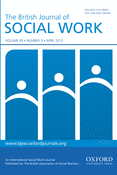-
Views
-
Cite
Cite
Saila Huuskonen, Pertti Vakkari, Selective Clients' Trajectories in Case Files: Filtering Out Information in the Recording Process in Child Protection, The British Journal of Social Work, Volume 45, Issue 3, April 2015, Pages 792–808, https://doi.org/10.1093/bjsw/bct160
Close - Share Icon Share
Abstract
The aim of the article is to explore how, why and what type of information social workers filter out from case records in child protection. Recording is understood as a process of four partially overlapping phases: encountering with the stakeholders, making notes, recording by a client information system and reading the case records. The data consist of social workers' and social work managers' interviews and social workers' observation and verbal accounts in natural work settings. The findings show that information was filtered out in each phase. The intentional reasons were often shaped by social context and norms. The unintentional reasons, instead, were often related to everyday realities at work. In the records, the information filtering manifested in wording the text, regulating the amount of details and, in some cases, omitting certain topics fully. The information gaps generated by filtering were faced and interpreted when the records were read. The role of the information system in reducing client information was minor compared to human actors.




